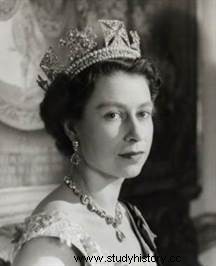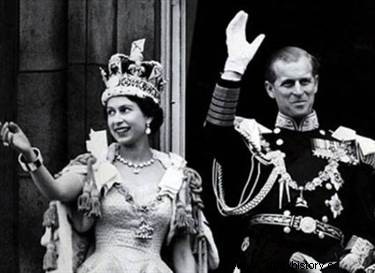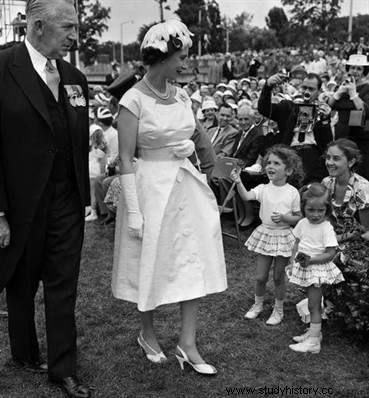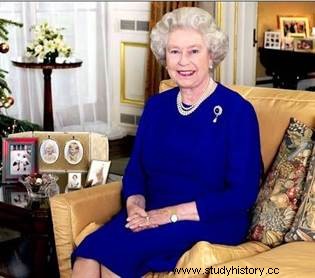 Elizabeth II (Elizabeth II in English), Queen of Great Britain and Northern Ireland since 1952, has also been the titular head of state of fifteen other countries from the former British Empire, such as Canada, Australia and New Zealand. During his long reign , Queen Elizabeth II saw fifteen prime ministers parade through Buckingham Palace, including Winston Churchill, Margaret Thatcher and Tony Blair. Constrained by tradition to strict political neutrality, she essentially has a role of representation and travels the world on official trips. Heir to a long tradition, she had to adapt (more or less willingly) to the contingencies of modernity to maintain the adherence of her people to the British monarchy .
Elizabeth II (Elizabeth II in English), Queen of Great Britain and Northern Ireland since 1952, has also been the titular head of state of fifteen other countries from the former British Empire, such as Canada, Australia and New Zealand. During his long reign , Queen Elizabeth II saw fifteen prime ministers parade through Buckingham Palace, including Winston Churchill, Margaret Thatcher and Tony Blair. Constrained by tradition to strict political neutrality, she essentially has a role of representation and travels the world on official trips. Heir to a long tradition, she had to adapt (more or less willingly) to the contingencies of modernity to maintain the adherence of her people to the British monarchy .
A princess not meant to rule
Elisabeth Alexandra Mary, great-great granddaughter of Queen Victoria, was born in London on April 21, 1926. She is the eldest daughter of the Duke and Duchess of York , of the House of Windsor. Princess Elisabeth only began her apprenticeship as a queen at the age of ten, when her father ascended the throne following the abdication of her older brother Edward VIII, the Duke of Windsor, in 1936. During the World War II, she made her first public appearances and joined the female corps of the United Kingdom army. In 1940, she made her first radio address to address children who had been evacuated to the countryside. Cautious and reserved, even distant, a lover of horse riding, she married Prince Philippe of Greece, who became Duke of Edinburgh, in 1947. Four children were born:Charles, Prince of Wales (in 1948), Anne (1950), Andrew (1960) and Edward (1964).
 On February 6, 1952, on the death of King George VI, his eldest daughter Elizabeth succeeded him:the first woman to ascending the throne of England from Victoria (who reigned from 1837 to 1901), she was consecrated by Time magazine as the "man of the year" 1952. The day she was proclaimed head of the Commonwealth, a group of countries linked to the Crown, to which a quarter of the world's population belongs, she declares:“May God help me to carry out with dignity this heavy task which falls to me so early in life! ". She is twenty-six years old. The solemn coronation took place the following year, on June 2, 1953. Beyond the ceremony, it was its live television broadcast that was an event.
On February 6, 1952, on the death of King George VI, his eldest daughter Elizabeth succeeded him:the first woman to ascending the throne of England from Victoria (who reigned from 1837 to 1901), she was consecrated by Time magazine as the "man of the year" 1952. The day she was proclaimed head of the Commonwealth, a group of countries linked to the Crown, to which a quarter of the world's population belongs, she declares:“May God help me to carry out with dignity this heavy task which falls to me so early in life! ". She is twenty-six years old. The solemn coronation took place the following year, on June 2, 1953. Beyond the ceremony, it was its live television broadcast that was an event.
Elizabeth II crowned:a television event
The coronation of Queen Elizabeth II is the first opportunity for Television to offer a great spectacle to viewers around the world. They were still few in number, but from the beginning of 1953 the purchases of positions skyrocketed. In France, less than 4,000 receivers were in service in 1950. Three years later, 60,000 sets were switched on to follow the ceremony. In the neighborhoods, in the villages, the neighbors flock to the happy owners of small skylights. Cafetiers fit out their rooms and rent seats, as in the cinema. Elsewhere, public screenings take place on the big screen.
In Paris, the report is screened in front of selected audiences, in specially equipped cinemas. Despite protests from foreign television, it is the British channel BBC which has exclusive operations. Thanks to the presence of French-speaking Quebec in the Commonwealth, the French benefit from live reporting in their language, provided by Jacques Sallebert, the London correspondent of the RTF (Radiodiffusion Télévision française).
In London in the throes of Coronation Day fever, crowds line the carriage route to Westminster Abbey. On the head of Elizabeth, forty-second monarch since William the Conqueror in the 11th century, Queen of Great Britain, Scotland and Northern Ireland, Head of the Church of England and the Commonwealth, Archbishop of Canterbury poses the heavy crown of Saint Edward, adorned with a thousand precious stones. The party is grand, the commentators lyrical.
A popular sovereign
While on the eve of the Second World War the monarchy was hated by the working classes, Elizabeth II achieved the miracle of making it popular in a country where the sovereign had a role symbolism all the more important as it is deprived of any real power. “We love you, ma'am. You are doing a good job. We are proud of the royal family”, headlined the Labor-leaning daily The Daily Mirror, as a gift for its sixtieth birthday.
 A mystery remains:how Elizabeth II, one of the richest people in the world, came to to give substance to an image of a peaceful, tea-drinking bourgeois, with legendary hats and handbags? Is it the strength, under a dull appearance, of an unspontaneous character joined to a great sense of the dignity of his office? This is how she never wanted to receive the Duchess of Windsor, guilty in her eyes of being an amoral schemer, or how she broke the romance between her sister Margaret and Captain Peter Townsend.
A mystery remains:how Elizabeth II, one of the richest people in the world, came to to give substance to an image of a peaceful, tea-drinking bourgeois, with legendary hats and handbags? Is it the strength, under a dull appearance, of an unspontaneous character joined to a great sense of the dignity of his office? This is how she never wanted to receive the Duchess of Windsor, guilty in her eyes of being an amoral schemer, or how she broke the romance between her sister Margaret and Captain Peter Townsend.
Still, the good grace with which she conscientiously plays her role is unanimously appreciated. Her personality devoid of any salient feature allows the public to identify with her, to empathize with the worries caused by the blunders of her husband and the escapades of so many members of her family, finally to applaud the marriage of her children. And the success continues, because, in the permanent spectacle offered to the world by the Windsor saga, the distribution of supporting roles is constantly being renewed thanks to the arrival, by marriage or by birth, of new actors. The private life of the royal family is, by far, the favorite subject of the British popular press. It also provides comfortable income to many newspapers in other countries, including France.
A contested monarchy
In the 1990s, a series of events raised the challenge to the monarchy. In 1992, the Queen was faced with the divorce of two of her children, Anne and Andrew, then the separation of Prince Charles and the popular Princess Diana, against the backdrop of a media storm that the English monarchy had the greatest difficulty in managing. In 1992, a fire ravaged Windsor Castle. The significant restoration costs opened a virulent debate on the financing of the work, with many voices rising to have it borne by the queen. To appease critics, the monarchy's civil list is reduced and the queen will now have to pay income tax.
In 1997, Elizabeth II did not immediately perceive the immense emotion caused in the population by the death of Diana, her former daughter-in-law. As the Queen stays at her Balmoral residence in Scotland, keeping her grandchildren Princes William and Harry out of the media storm, British opinion does not understand her apparent indifference. The sovereign must return to London and address her people in a televised address the day before Diana's funeral. Thereafter, the marriages of Prince William with Kate Middleton, then that of Prince Harry with Meghan Markle will blow a saving wind of freshness and modernity on the crown. Finally, Prince Charles remarried Camilla Shand, titled Duchess of Cornwall for the occasion.
Elizabeth II, queen to the end
 While the British monarchy is regularly criticized for its lack of "popular" fiber, the obsolescence of its institutions and its lifestyle, a majority of Britons remain attached to the symbol of unity and the role of representing the Queen and her family. This justifies in the eyes of the taxpayers the 30 million pounds that the royal civil list costs them each year. His Golden Jubilee in 2002, which celebrated 50 years since his accession to the throne, was considered a popular success.
While the British monarchy is regularly criticized for its lack of "popular" fiber, the obsolescence of its institutions and its lifestyle, a majority of Britons remain attached to the symbol of unity and the role of representing the Queen and her family. This justifies in the eyes of the taxpayers the 30 million pounds that the royal civil list costs them each year. His Golden Jubilee in 2002, which celebrated 50 years since his accession to the throne, was considered a popular success.
Elisabeth II, who considers the coronation a sacrament from which only death will release her, beat the longevity of Victoria's reign:70 years in 2022. The sovereign's public functions, hostile to the idea of an abdication, are increasingly assumed by his son Prince Charles.
Bibliography
- Elizabeth II, the Queen, biography of Jean des Cars. Perrin, 2018.
- Elizabeth II. The Life of a Modern Monarch, by Sally Bedell Smith. Ecuadors, 2018.
- The Queen:Elisabeth II, an exceptional destiny, by Guillaume Picon. Glénat, 2019.
To go further
- The Crown, television series by Peter Morgan.
- The Queen, film by Stephen Frears, 2006.
